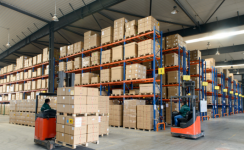
Application of RFID handheld terminal in warehouse logistics management plan
[ad_1]
Warehousing logistics management has been widely used in various industries. The RFID warehousing logistics information management system can improve the transparency of supply chain management and inventory turnover, effectively reduce the loss of stocks, and improve the efficiency of warehousing and logistics within the enterprise. The warehousing logistics information management system is composed of RFID handheld terminals and RFID warehousing logistics information management systems installed in mobile terminals.

The staff can directly complete the warehousing/outgoing/inventory management, basic/system information management and data statistical analysis and other links at the job site by operating the handheld terminal, reducing the efficiency and error rate of manual operations; using wireless networks to carry out Data interaction, through the control and management of data authority, data processing has a complete error correction mechanism, can discover and process difference data in time, and has a flexible data processing mechanism.

Handheld terminal application
Warehouse management
After receiving the warehousing order, the product will be put into the warehouse according to certain rules. When the RFID electronic tag (ultra high frequency) enters the electromagnetic wave range of the RFID fixed reader, it will be actively activated, and then the RFID electronic tag and RFID fixed reading The writer communicates, and the relevant data can be collected into the system. You can also directly use the handheld terminal to collect data on the goods at close range. Then compare the relevant data with the order to check whether the quantity and model of the goods are correct. If there are errors or omissions, perform manual processing. Finally, the goods are transported to the designated location and placed in accordance with the rules.

Outbound management
Use the RFID handheld terminal to collect the information of the RFID electronic tag, check whether it corresponds to the plan, according to the picking plan, the goods out of the warehouse are sorted and processed. When there is an error, an alarm will be issued, and the staff can handle it on the spot, and finally The data is sent to the management center to update the database to complete the delivery.

Inventory management
In accordance with the requirements of warehouse management, carry out regular and irregular inventory. Traditional inventory is time-consuming, labor-intensive, and error-prone. All these RFID solves these problems. When there is an inventory plan, the RFID handheld terminal is used to carry out the inventory scan of the goods, and the information of the inventory can be transmitted to the back-end database through the wireless network and carried out with the information in the database. Comparing, the generated difference information is displayed on the RFID handheld terminal in real time, and it is provided to the inventory staff for verification. After the inventory is completed, the inventory information is checked with the database information in the background, and the inventory is completed.

Software and system applications
The industrial handheld terminal is equipped with Android 5.1 system, 4G communication, WiFi, Bluetooth and other wireless communication functions, making data transmission more convenient and faster. At the same time, it provides api interface, project manager and software engineer’s technical support, so that enterprises or system integrators can develop relevant software and system integration according to specific project requirements to ensure that it meets the individual needs of each enterprise. Different personnel are given different permissions, and warehouse managers at all levels can query and perform related business operations for inventory information in different dimensions. And directly use the handheld terminal to perform simple data analysis, and provide accurate inventory information to the superior in real time, which can improve the accuracy of goods inquiry, reduce the inventory level, and improve the efficiency of the logistics system to strengthen the competitiveness of the enterprise.

[ad_2]



